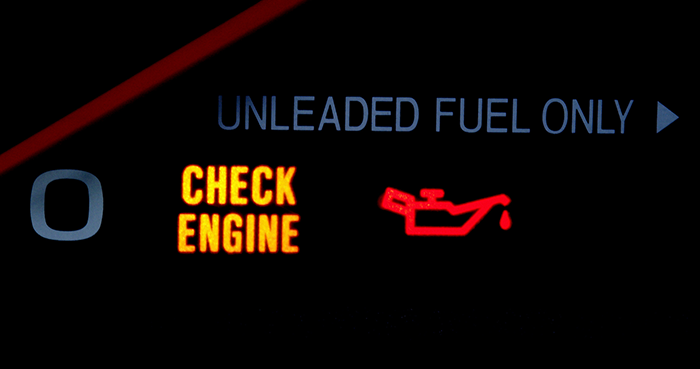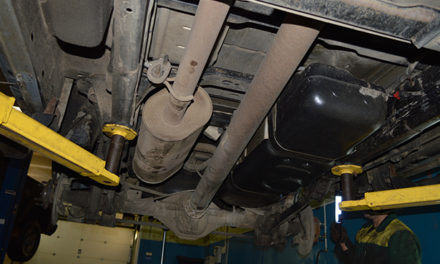If you’re a fan of the show “Big Bang Theory,” you know that Penny’s “Check Engine Light” is always on – to Sheldon’s consternation. He thinks it means the end of the world while she dismisses it as a minor annoyance, but who’s right?
As it turns out, that annoying little light switches on when something triggers a diagnostic trouble code (DTC) in the engine’s computer. Depending on the type of fault, such as a problem with the fuel delivery system, the light may remain on, flash, or come and go. Since the light is so ambiguous, there’s no way to know what’s going on without running a diagnostic test. If no other warning lights are triggered and the engine seems to be running OK, then you can probably continue driving for the moment, but you should get the problem investigated sooner rather than later. But if you notice other warning signs – such as funny smells or sounds – then stop driving until the problem is repaired.
Reading Trouble Codes
Plug your scan tool into the IBD II connector underneath the instrument panel, by the steering column. Or, you could go to an auto parts store and see if they’ll do it for free.
Write down any code number(s) that pop-up, but do not erase them until you’re sure you have them recorded safely!
These codes indicate which systems or sensors have a problem. If your scan tool doesn’t define the code for you, then look it up online or in your shop manual. This will show you where to start troubleshooting.
Clearing Trouble Codes
The best method uses a scan tool; this instructs the computer to erase the codes without changing other learned settings that are needed for normal operation. Do not try to clear the codes by disconnecting the battery; this will erase the codes plus any other settings that the engine needs to function most efficiently and effectively.
Be aware that clearing the codes will not turn off your “Check Engine Light” permanently; eventually, an unfixed problem will trigger the codes again and switch on your warning light.
What Problems Do Trouble Codes Indicate?
Here’s a sampling of what trouble code diagnostics, but by no means is this list complete:
- P0100-P0104, P0171-P0175 – Mass Airflow (MAF) Sensor
- P0115-P0119 – Coolant Sensor
- P0130-P0147 – Oxygen Sensor
- P0171, P0174 – Lean Fuel Mixture
- P0172, P0175 – Rich Fuel Mixture
- P0300 – Random Misfire
- P0301-P0312 – Engine Misfire
- P0335-P0339 – Crankshaft Position Sensor
- P0340-P0349 – Camshaft Position Sensor
- P0400-P0409 – Exhaust Gas Recirculation (EGR)
- P0420-P0439 – Catalytic Converter
- P0440-P0457 – Evaporative Emission Control (EVAP)






![[Vehicle Fitment-1]: Compatible with Chevrolet HHR 2009-2011 L4 2.2L/2.4L, Malibu 2010 2012 L4 2.4L [Vehicle Fitment-2]: Compatible with Pontiac G6 2010 L4 2.4L---It Fits the Model without PZEV Engine [Reference Number]: The A-Premium Fuel Injector's...](https://m.media-amazon.com/images/I/41ff1aFtMKL._SL100_.jpg)

![[Fit for Ford E150 models] 2003-2004 E-150 5.4L | 2003-2004 E-150 Club Wagon 5.4L | 1997-1998 E-150 Econoline 4.6L | 2000-2002 E-150 Econoline 4.6L | 1990-1996 E-150 Econoline 5.0L | 1997-2002 E-150 Econoline 5.4L | 1990-1996 E-150 Econoline 5.8L | 1...](https://m.media-amazon.com/images/I/41K8npit6ML._SL100_.jpg)

![[Vehicle Fitment]: Compatible with Dodge Durango 1998 1999 2000 2001 2002 2003 V6 3.9L V8 4.7L/5.2L/5.9L [Reference Number]: 52102862AB, 5003465AB, 5003465AD, E7117M, FG0238, P74803M, F3128A [Package Contents]: 1 x Fuel Pump Assembly, Packaging Type:...](https://m.media-amazon.com/images/I/41oNxJrbzkL._SL100_.jpg)
![[Vehicle Fitment]: Compatible with Kia Sorento 2005 2006 V6 3.5L [Reference Number]: 31150-3E230, 311503E230, 311503E230DS, 311503E500, E8676M, FG1260, P76142M, SP3036M [Package Contents]: 1 x Fuel Pump Assembly, Packaging Type: Box [Related Parts]: ...](https://m.media-amazon.com/images/I/41um+nTM5yL._SL100_.jpg)